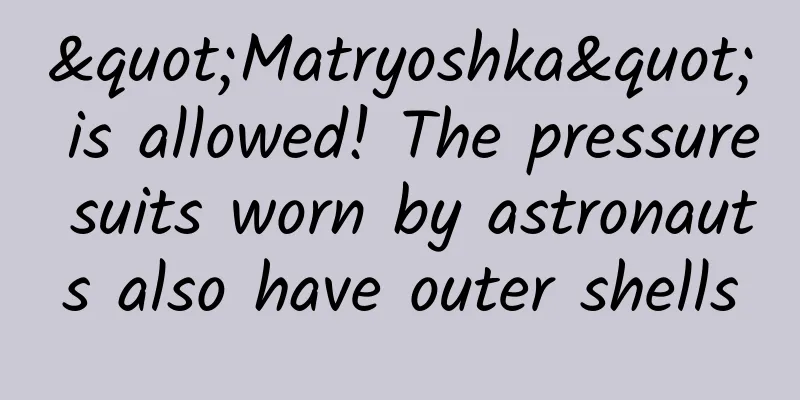"Matryoshka" is allowed! The pressure suits worn by astronauts also have outer shells

|
With the full completion of the Chinese space station, more and more Chinese astronauts have appeared in the public eye. Many people may have noticed a detail, that is, when the rocket is launched and when the spacecraft returns, the astronauts always wear a very special suit, which is blue and white in appearance and has some pipelines all over the body. This special suit is the life guardian of the astronauts - the pressure suit. The pressure suits currently used by Chinese astronauts How pressure suits were invented Pressure suits first appeared in the aviation field. After humans gained the ability to fly, the aviation industry rose rapidly. Various new aircraft continued to appear in the early 20th century, and the aviation industry showed a vibrant and competitive scene. At that time, people found that as the planes flew higher and higher, in addition to the continuous decrease in temperature and the need to take measures to keep warm, the atmospheric pressure was also constantly decreasing. Pilots often suffered from decompression sickness when flying at high altitudes for a long time, affecting their health and aviation safety. The concept of "pressure suits" was born. As the name implies, pressure suits are clothes that can maintain a certain air pressure inside the clothes. Although current aircraft already have pressurized cabins, most aircraft flying at around 10,000 meters do not require pilots or passengers to wear such complicated clothes, but on some aircraft that sometimes need to fly at ultra-high altitudes, such as fighter jets or reconnaissance aircraft, pressure suits are still required. Pressure suits worn by pilots during high-altitude cruises in the 1930s After the end of World War II, aircraft quickly entered the jet age, and high and fast jet aircraft quickly replaced propeller aircraft flying in the sky. During the Korean War, Soviet pilots flying jet MiG-15 fighters called for professional and easy-to-use pressure suits. In order to produce advanced pressure suits, a group specializing in the research and production of pressure suits was established, namely the Zvezda Research and Production Association, which was restructured into a joint-stock company in 1994. The company was originally established to provide pressure suits and ejection seats for the Air Force and aerospace projects. Later, it had deep technical accumulation and experience in the field of pressure suits and ejection seats. At present, all aviation and aerospace pressure suits used in Russia are produced by Zvezda. What did the original space pressure suit look like? On April 12, 1961, Soviet astronaut Yuri Alexeevich Gagarin entered space wearing an SK-1 pressure suit, becoming the world's first astronaut to enter space. Gagarin wearing the SK-1 pressure suit to the launch site Initially, the First Design Bureau that designed the Vostok spacecraft believed that the design of the spacecraft was very safe and did not require wearing such a complicated pressure suit. Only clothes that could keep warm were needed. In addition, the pressure suit and the life support equipment that went with it were heavy. The extra weight could be saved to install additional instruments. Finally, Korolev decided that 500 kilograms of weight could be saved for the pressure suit and life support equipment, but these things had to be in place before the end of 1960, and the Star Bureau did an excellent job. The SK-1 pressure suit is a customized space suit for one person. It can be put on in 10 minutes with the help of another person. The entire pressure suit is made of an outer layer of orange-yellow cloth and an inner rubber lining. Each pressure suit is customized by cutting and bonding rubber. The mask is directly connected to the pressure suit and cannot be removed. There is a ventilation hose at the right rib of the pressure suit, which can be connected to the life support equipment of the Vostok spacecraft. The life support system can ensure the air pressure of the pressure suit and filter out the carbon dioxide in the exhaled gas of the astronauts. In order to ensure the mobility of astronauts during pressurization, there is a special soft hinge inside the pressure suit in the bending area of the arms and legs. In the decompression environment of the spacecraft, the pressure suit will provide a safe air pressure environment after locking the mask, and the gas cylinders in the spacecraft will provide oxygen to maintain the vital signs of the astronauts. The SK-1 pressure suit can ensure that astronauts maintain their vital signs for about 5 hours when the spacecraft is depressurized or the cooling system fails, and provide protection when they fall to the ground or splash into the water after being ejected from the spacecraft. Compared with the first American space pressure suit, this pressure suit is more advanced in that it has a built-in space toilet. In 1963, the world's first female astronaut Valentina Tereshkova entered space, wearing the SK-2 which is basically the same as the SK-1, but with adjustments for women in terms of the toilet. What if space flight didn't have a pressure suit? When the world's first multi-crew spacecraft "Voskhod 1" was launched, the three astronauts were not wearing pressure suits because the rocket capacity was limited at the time. In order to ensure that the weight of the manned spacecraft would not exceed the standard and that the spacecraft could accommodate three astronauts, the pressure suits and their supporting life support systems were omitted. It was not until a tragedy occurred that the Soviet Union re-recognized the importance of pressure suits and their supporting life support equipment. On April 19, 1971, the Soviet Union successfully launched the world's first space station, Salyut 1. On June 6, 1971, the Soyuz 11 spacecraft successfully entered Salyut 1, becoming the world's first group of astronauts to enter a space station. At first, everything went smoothly, and the astronauts completed various tasks in orbit. However, when they returned to the ground on June 29, an accident occurred. Soyuz 11 crew At 11:16 p.m. on the 29th, the return capsule of Soyuz 11 landed in the desert of Kazakhstan. The personnel who came to pick it up tried to contact the astronauts in the capsule, but there was no response. After opening the hatch, the personnel found that the three astronauts, Commander George Dobrovolsky, Engineers Vladislav Volkov and Victor Pasayev, had no vital signs. By studying the black box inside the spacecraft, it was found that after the Soyuz 11 spacecraft separated from the re-entry capsule at an altitude of 150 kilometers, the internal air quickly escaped from the re-entry capsule. In just 115 seconds, the re-entry capsule almost became a vacuum, and the three astronauts died before returning to the ground. This tragedy made the Central Experimental Machine-Building Design Bureau (the reorganization of the 1st Design Bureau), which designed the Soyuz spacecraft, learn from its mistakes and begin to seriously study various situations that might threaten the lives of astronauts during the spacecraft's ascent and return. The pressure suit returned to the new Soyuz spacecraft, the Soyuz 7K-T, launched on June 26, 1972. After that, no astronauts died while riding on the Soyuz spacecraft, making the Soyuz spacecraft one of the safest manned spacecraft in the world. Space pressure suits can also be tailored The Soyuz 7K-T is the first manned spacecraft in the Soyuz spacecraft to use pressure suits. In order to reduce weight and accommodate the life-support equipment required by the pressure suit, the crew was reduced from 3 to 2. However, new problems were placed in front of the R&D personnel. At that time, the Soviet Union did not have pressure suits suitable for wearing in the "Soyuz". The pressure suits that could be selected were basically too large and too heavy. In order to have a pressure suit that could be used in the "Soyuz" return capsule, the Star Bureau received another task and redesigned the pressure suit designed for Air Force pilots, and made the "Falcon"-K pressure suit. The Falcon-K pressure suit is designed specifically for astronauts on the Soyuz spacecraft. In order to meet the weight reduction requirements, the weight of this type of pressure suit is controlled to 10 kilograms. Each pressure suit can be connected to the onboard life support equipment in the return capsule to provide air, electricity, ventilation and water. The pressure suit does not hinder the astronauts from performing various operations in the return capsule, and can protect the lives of astronauts under decompression. The pressure suit can also allow astronauts to float on the water when the spacecraft return capsule deviates from its route and falls into the sea. The pressure suit consists of two layers of outer shell, the outer layer is made of white nylon canvas with blue trim, and the inner layer is made of rubber stitching. A hinged plastic mask is directly connected to the pressure suit. There is a pressure gauge on the left wrist, and a watch can also be worn. A mirror is fixed to the right wrist. The gloves of the pressure suit can be removed. The boots are connected to the pants and cannot be separated. There are folds at the joints to facilitate movement. There is an electrical pipe on the right side of the abdomen, and a pressure valve and ventilation pipe on the left side, which can be connected to the air conditioner held in the astronaut's left hand when on the ground. The design has two pouches for storing things. There are elastic bands on the back and other places to adjust the body shape. When entering this type of pressure suit, the astronaut will enter through the opening on the front of the pressure suit, and then use ropes to seal the front and crotch like tying shoelaces. Each Falcon pressure suit is customized according to the astronaut's body shape. The astronauts will wear the Falcon pressure suit at the training center and sit in the customized seat for two hours to ensure that the space suit fits well and there is no discomfort. Then the astronauts will repeat the same steps in the vacuum chamber. Before takeoff, the pressure suit has a final adjustment opportunity. Before takeoff and returning to the ground, the astronauts will connect the electrical and air supply hoses of the pressure suit to the life support device and buckle the mask. The mask can only be opened after it is confirmed to be safe. This set of procedures is still used today. The Falcon-K is a pressure suit tailored for Soyuz spacecraft astronauts The Falcon-K pressure suit began production in 1971 and was first used by the crew of the Soyuz 12 spacecraft on September 27, 1973. The Falcon-K pressure suit was also used until the newer Falcon-KV2 was put into use in 1980. "Material dolls" are allowed! Space pressure suits also have outer shells After the K-type pressure suit was put into use, the development plan of the new "Falcon" pressure suit was put on the agenda by the Star Bureau. Between 1973 and 1980, the Star Bureau successively produced the "Falcon"-KM and "Falcon"-KV. Unlike the K-type, the KM and KV types use a top-to-bottom separation method, with the upper and lower body connected by a zipper. Both types are also equipped with liquid cooling underwear to remove body heat to ensure the comfort of astronauts. However, due to various reasons such as performance, reliability, and complexity, these two types of pressure suits were not put into use. When the Star Bureau launched a new generation of pressure suits, the model was already KV2. "Falcon" KV2 pressure suit The Falcon-KV2 has been in service since 1980 and is still in use today. The pressure valve of this type has been moved to the upper middle chest of the pressure suit, so that astronauts can adjust the pressure level of the pressure suit with either hand. The electrical and oxygen supply ventilation hoses have been repositioned, and the shoelace seal has been cancelled and replaced with two much more convenient zipper seals on the front, which greatly reduces the time astronauts wear the pressure suit, but the shoelace seal is still retained in the crotch area. Japanese billionaire Yusaku Maezawa is undergoing a 2-hour test wearing a KV2 pressure suit The material of the KV2 type has been improved. The inner layer has been changed from the rubber lining of the K type to polycaprolactam, which reduces the weight. The KV2 type has enlarged the area of the mask, allowing astronauts to have a better field of vision. The KV2 type does not use the liquid cooling underwear of the KM and KV types to dissipate heat, but still uses the same air cooling as the K type. This is mainly because liquid cooling requires a more complex pump set, and the pressure suit is always in the presence of gravity or overload. When using liquid cooling underwear in this scenario, the weight will hinder the normal operation of liquid cooling. However, the KV2 type inherits the design of the hands and legs from the previous KV type. The KV2 type still has a pressure gauge on the left wrist and a mirror on the right wrist. In other aspects, the KV2 type is basically the same as the K type. Here is a little extra knowledge: when the temperature at the Baikonur launch site has dropped to the point where the pressure suits alone can no longer provide enough insulation for the astronauts, the staff will put on extra warm clothes for the astronauts before they board the spacecraft. This full-body warm suit can keep the astronauts warm even at minus 50 degrees Celsius, and it will be taken off after the astronauts enter the spacecraft. Because of its pure white appearance, people call this suit "the big white bear." Thermal clothing over pressure suit The first type of "Falcon" pressure suit was put into use in 1973, and half a century has passed. In these 50 years, the "Falcon" pressure suit has escorted hundreds of astronauts from various countries from the ground and returned safely from space. In the foreseeable future, since the Russian Soyuz spacecraft will not be retired soon, the "Falcon" pressure suit that matches it will not be retired soon, but will continue to serve until the Russian "Eagle" spacecraft is put into use. It may be some time before this day comes, and the "Falcon", a model worker, will continue to ensure that astronauts from various countries can go to space and return to Earth for a long time. |
<<: An encounter ten thousand years ago stirred up a vortex in the accretion disk!
>>: Does frequent anger really cause nodules? The truth is...
Recommend
How to write advertising copy? 50 classic movie lines, 50 examples!
For a crazy movie collector sometimes "One l...
The world's first satellite successfully entered orbit!
The National Space Administration announced today...
Delivery capability is the best in the world! Tianzhou launches new products, 3 launches in 2 years
In 2023, China officially entered the manned spac...
Electric Motorcycle News: MG ZS vs Honda XR-V finally surpasses Japanese cars in engine
Speaking of the MG brand, its brother Roewe may b...
Revealing the most powerful console on earth, Xbox Scorpio will be more fun to play old games
We now know that in order to ensure that PS4 Pro i...
The rules for Douyin corporate accounts to achieve 1 million likes!
This article studied 88 brand clients and 5,459 p...
World Tuberculosis Day丨It is the second largest infectious killer in the world!
Recently, the COVID-19 pandemic has struck again....
New user growth strategy: from traffic to retention
Traffic is the most valuable thing on the Interne...
Super recommendation detonates the homepage, leveraging the homepage's average monthly traffic of 1 million to continuously grow (full practical operation) 7 days fast low-cost new users
Jiucai e-commerce · Lao Tao will help you easily ...
Do you understand the full-stack thinking ability behind event promotion planning?
What kind of full-stack thinking ability is neede...
A new game restriction calendar for minors is available! How can parents effectively manage their children’s internet and gaming time during holidays?
Winter vacation is here Game platforms have relea...
What is the core of what Liu Genghong said? Don’t wait until you get hurt to understand!
Mixed Knowledge Specially designed to cure confus...
What's the matter with Shanghai setting up an undergraduate major in home economics? What is the specific situation?
What's the matter with Shanghai setting up an...
Once a jay hides its food, does it really remember it?
The sower in the forest - Jay The jay belongs to ...
The "Lotus Birthday Candles" from childhood have gone abroad and become a hit, with a loud sound that can last for a year?
I wonder if you still remember the "lotus bi...









